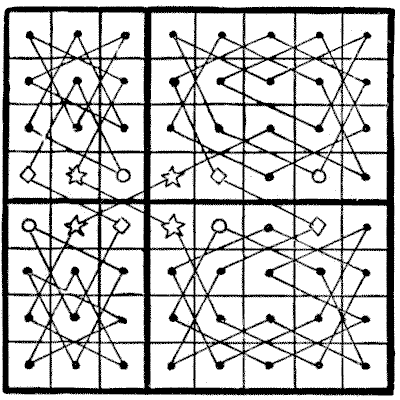(related to Problem: The Board In Compartments)
In attempting to solve this problem it is first necessary to take the two distinct compartments of twenty and twelve squares respectively and analyze them with a view to determining where the necessary points of entry and exit lie. In the case of the larger compartment, it will be found that to complete a tour of it we must begin and end on two of the outside squares on the long sides. But though you may start at any one of these ten squares, you are restricted as to those at which you can end, or (which is the same thing) you may end at whichever of these you like, provided you begin your tour at certain particular squares. In the case of the smaller compartment, you are compelled to begin and end at one of the six squares lying at the two narrow ends of the compartments, but similar restrictions apply as in the other instance. A very little thought will show that in the case of the two small compartments you must begin and finish at the ends that lie together, and it then follows that the tours in the larger compartments must also start and end on the contiguous sides.

In the diagram given of one of the possible solutions, it will be seen that there are eight places at which we may start this particular tour; but there is only one route in each case because we must complete the compartment in which we find ourself before passing into another. In any solution, we shall find that the squares distinguished by stars must be entering or exit points, but the law of reversals leaves us the option of making the other connections either at the diamonds or at the circles. In the solution worked out the diamonds are used, but other variations occur in which the circle squares are employed instead. I think these remarks explain all the essential points in the puzzle, which is distinctly instructive and interesting.
This eBook is for the use of anyone anywhere in the United States and most other parts of the world at no cost and with almost no restrictions whatsoever. You may copy it, give it away or re-use it under the terms of the Project Gutenberg License included with this edition or online at http://www.gutenberg.org. If you are not located in the United States, you'll have to check the laws of the country where you are located before using this ebook.